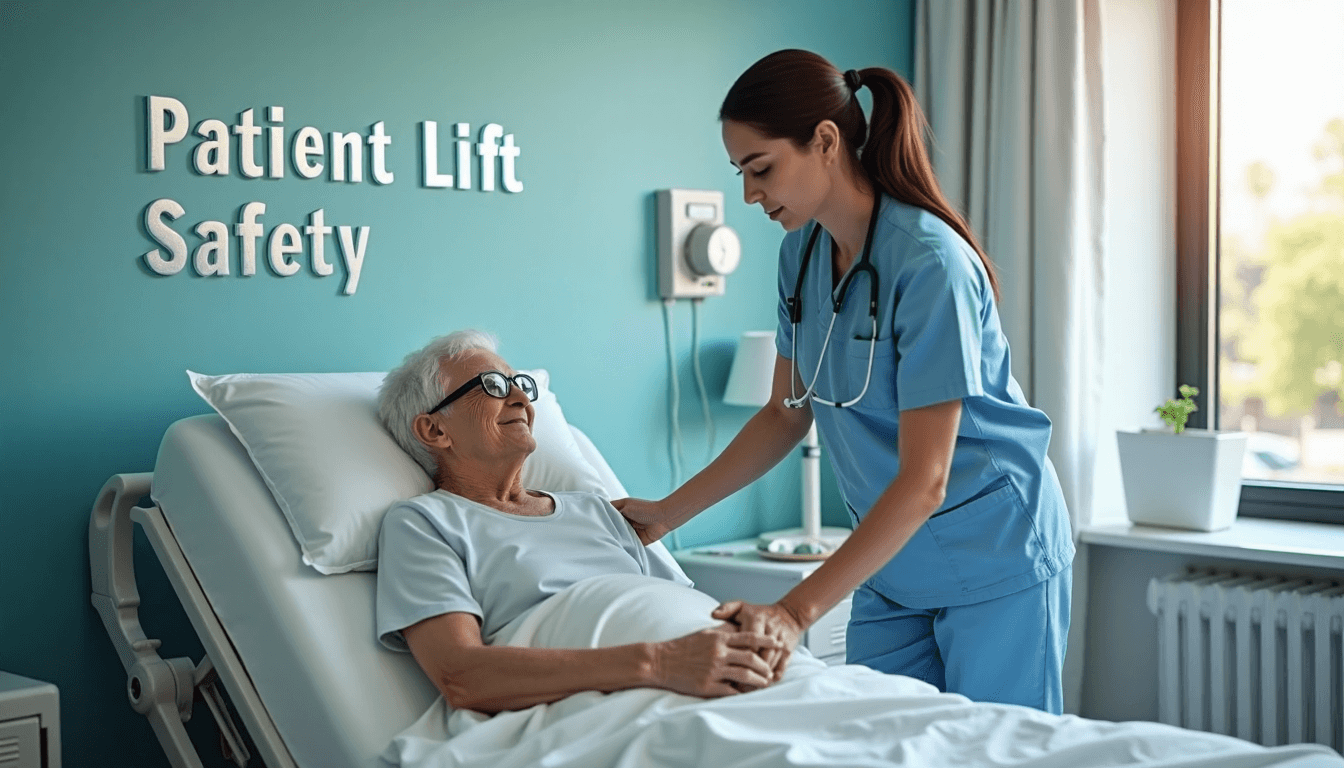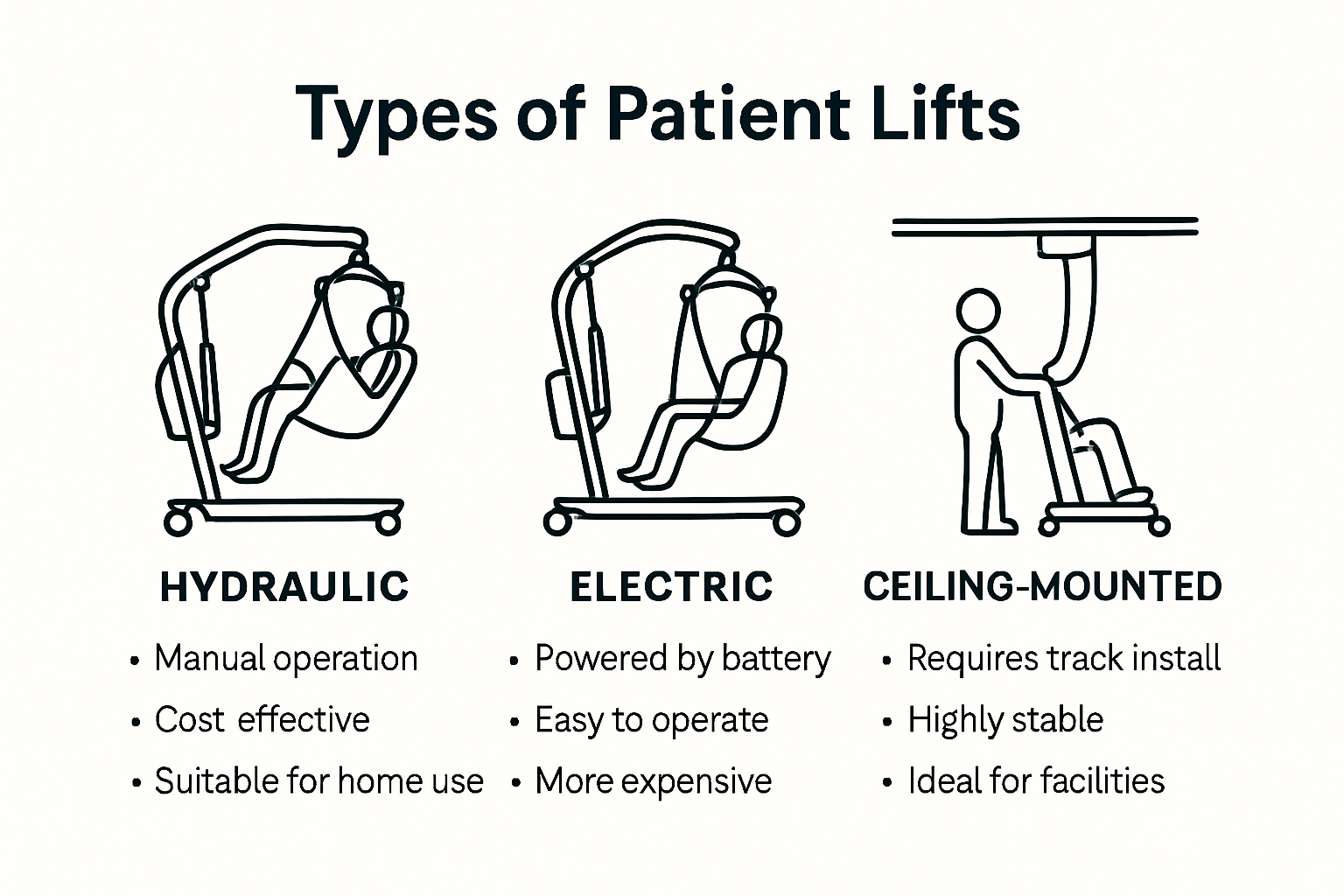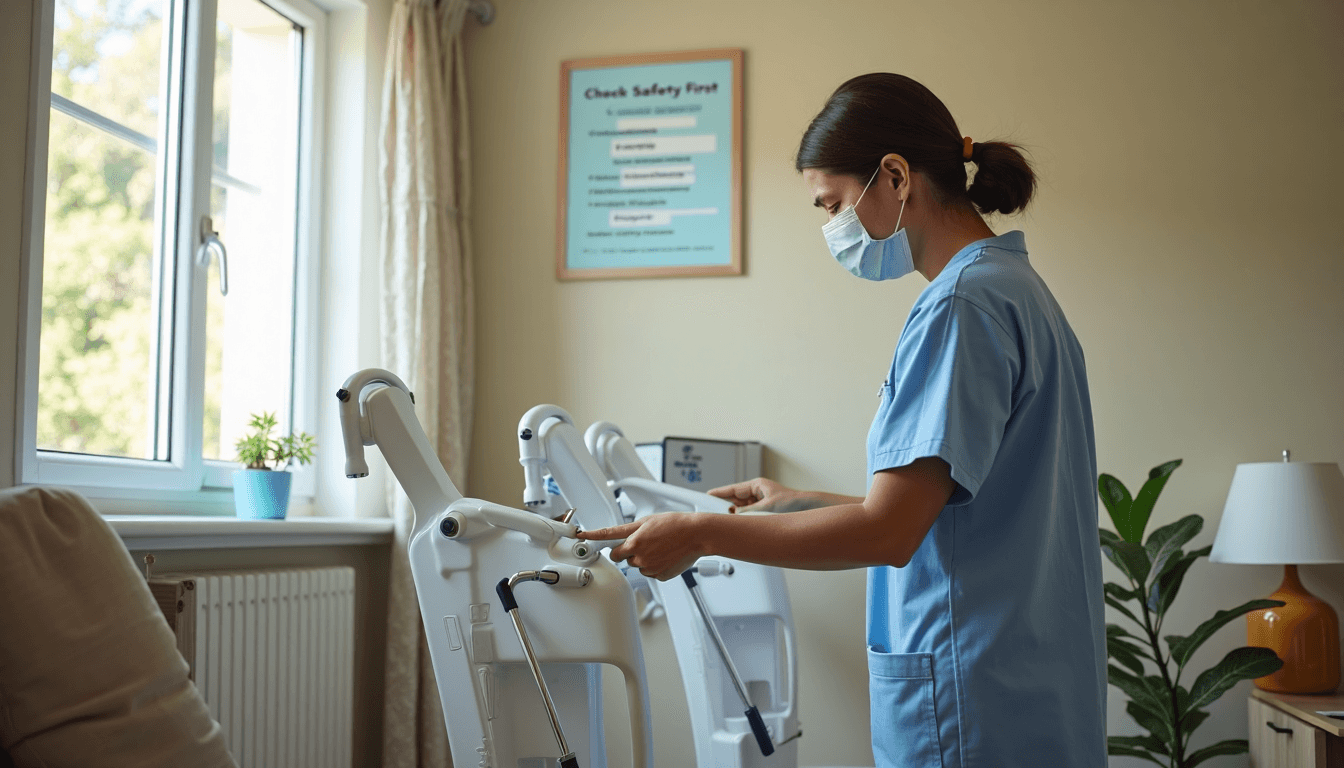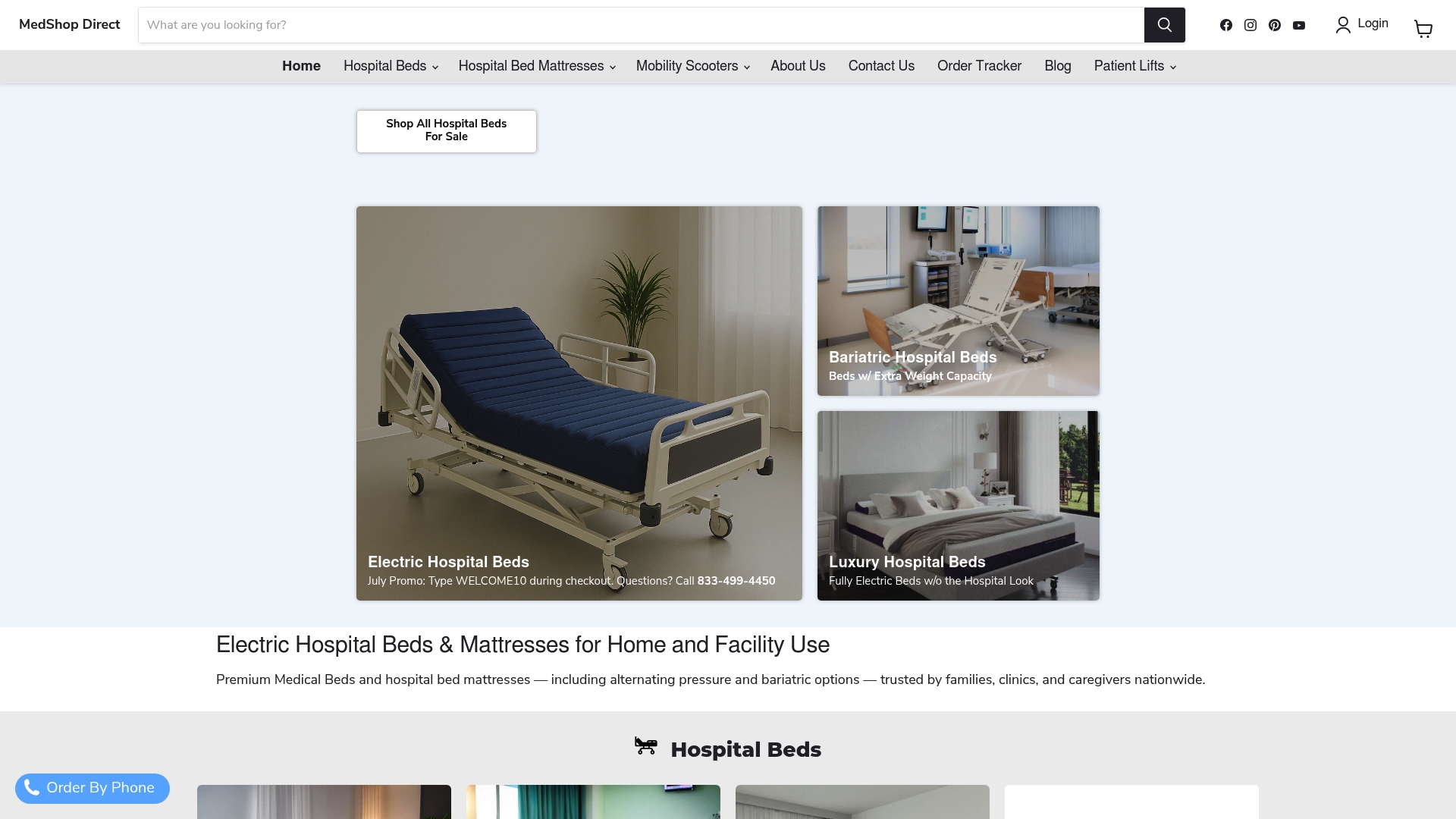

Choosing the right patient lift can mean the difference between a safe transfer and a painful accident. Surprising, right? More than 50 percent of caregiver injuries are linked to lifting or moving patients. Most people focus on the kind of lift, but here is the unexpected part. The safety features, like emergency stops and manual overrides, are the real lifesavers that protect both patients and caregivers every single day.
See our top Patient Lifts from brands like Joerns, Medacure, and Proactive, all with an automatic 10% discount applied and with a free sling.
| Takeaway | Explanation |
|---|---|
| Choose the Right Type of Lift | Selecting the appropriate patient lift is crucial, considering patient weight, mobility limitations, and caregiver capabilities for optimal safety and functionality. |
| Assess Environment for Lift Selection | Evaluate the home or facility environment for space constraints and accessibility to determine the most suitable lift type, ensuring ease of use and maneuverability. |
| Prioritize Safety Features | Essential safety mechanisms such as emergency stops, manual overrides, and robust locking casters must be checked to ensure safe operation during patient transfers. |
| Regular Training and Maintenance | Comprehensive training for caregivers and regular equipment inspections and maintenance are vital for preventing accidents and ensuring the longevity of patient lifts. |
Patient lifts are critical medical devices designed to safely transfer individuals with limited mobility between different surfaces such as beds, wheelchairs, and chairs. These essential mobility aids reduce physical strain for both patients and caregivers while ensuring safe, dignified patient movement.

Patient lifts can be categorized into several primary mechanical types, each serving unique medical transfer needs. Research from Johns Hopkins Medicine indicates that understanding these classifications is crucial for selecting appropriate mobility assistance.
Hydraulic Patient Lifts represent the most traditional transfer technology. These manual devices use hydraulic fluid mechanisms to create smooth lifting motions, allowing caregivers to manually adjust patient positioning. They typically feature adjustable width bases and removable slings, providing flexibility for various patient body types and transfer scenarios.
Electric Patient Lifts offer more advanced mobility solutions. Powered by rechargeable batteries, these lifts enable precise electronic control during patient transfers. Clinical research published in the Journal of Medical Engineering demonstrates that electric lifts significantly reduce caregiver physical strain compared to manual alternatives.
Ceiling mounted lifts represent a sophisticated patient transfer technology with unique advantages. Scientific studies have shown that ceiling lifts significantly reduce spinal loads on caregivers during patient transfers. These permanently installed systems offer several key benefits:
According to medical transfer efficiency research, ceiling lifts require less time for patient transfers (averaging 156.9 seconds) compared to floor lifts (averaging 273.6 seconds), highlighting their operational efficiency.
To help visualize the main types of patient lifts and highlight their unique attributes, the following table provides a concise comparison of mechanical and configuration types discussed.
| Lift Type | Power Source | Key Features | Best Use Scenario |
|---|---|---|---|
| Hydraulic Patient Lift | Manual (hydraulic) | Adjustable width, removable sling, manual effort | Flexible, cost-effective spaces |
| Electric Patient Lift | Electric (battery) | Powered lifting, precise control, reduced strain | Frequent transfer needs |
| Ceiling-Mounted Lift | Electric (track) | Room coverage, smooth transfer, less caregiver strain | Permanent multi-area transfers |
Choosing an appropriate patient lift depends on multiple factors including patient weight, mobility limitations, caregiver capabilities, and specific medical environment requirements. Key considerations include:
While various patient lift technologies exist, the primary goal remains consistent: ensuring safe, dignified, and comfortable patient mobility with minimal risk of injury to both patient and caregiver.
Proper training and understanding of each lift type’s unique operational characteristics are essential for maximizing their effectiveness and ensuring optimal patient care and safety.
STAFF PICK:
Compact Folding Design - Unique triangular frame folds flat without tools for easy storage and transport, weighing only 69.7 lbs
Adjustable Leg Width - Angled legs adjust from 22.4" to 39.4" internal width to navigate around wheelchairs, commodes, and furniture
340 LB Capacity - Powerful electric lift with 53.5" to 73.2" height range handles floor-to-bed transfers with rechargeable battery
Selecting an appropriate patient lift requires careful consideration of multiple factors to ensure optimal safety, comfort, and functionality for both patients and caregivers. The right lift can significantly improve mobility, reduce injury risks, and enhance overall quality of life.
Research from the National Institutes of Health emphasizes the importance of thoroughly evaluating individual patient requirements before selecting a patient lift. Critical factors include the patient’s weight, level of mobility, and specific medical conditions.
Weight Capacity stands as a primary consideration. Patient lifts are designed with specific weight ranges, and selecting a lift that cannot safely support a patient’s weight can lead to dangerous transfer situations. Medical equipment safety guidelines recommend carefully checking manufacturer specifications to ensure complete compatibility.
Patients with varying mobility levels require different lift configurations. Those with some independent movement might benefit from stand-assist lifts, while completely immobile patients need full-body sling support systems. Clinical mobility research indicates that matching the lift to the patient’s specific mobility level is crucial for safe and comfortable transfers.
According to senior care equipment experts, different lift types offer unique advantages for specific environments:
Space constraints play a significant role in lift selection. Homes and facilities with limited room may require more compact or versatile lift solutions. Measuring doorway widths, room dimensions, and potential movement paths is essential before making a final decision.
Budget remains a critical factor in selecting the right patient lift. Healthcare equipment procurement studies suggest considering not just initial purchase price, but also:
Additional practical considerations include battery life for electric models, ease of cleaning and sanitization, and compatibility with existing medical equipment. Some lifts offer modular designs allowing for future adaptations as patient needs change.
Consulting with medical professionals, physical therapists, and experienced caregivers can provide invaluable insights into selecting the most appropriate patient lift. Each patient’s unique circumstances demand a personalized approach to mobility assistance, ensuring safety, comfort, and dignity during transfers.

Purchasing a patient lift requires careful evaluation of multiple critical features to ensure safety, functionality, and long-term reliability. Understanding these key characteristics can help patients and caregivers make informed decisions that directly impact mobility and quality of care.
Research from the Food and Drug Administration highlights the paramount importance of safety mechanisms in patient lifting equipment. Critical safety features should include:
Weight Capacity represents a fundamental safety consideration. Medical equipment safety guidelines emphasize selecting a lift that can safely support the patient’s full body weight with an additional margin of safety. Manufacturers typically provide clear weight range specifications that should be meticulously reviewed before purchase.
To make it easy to review essential safety, ergonomic, and technical features to look for when evaluating a patient lift, the table below summarizes key considerations mentioned in this section.
| Feature Category | Key Elements/Recommendations |
|---|---|
| Safety | Emergency stop, manual override, locking casters, weight capacity |
| Ergonomics | Adjustable height, smooth controls, comfortable slings |
| Technical/Maintenance | Battery life, cleaning ease, part availability, warranty |
Beyond basic safety, ergonomic design plays a crucial role in patient comfort and caregiver efficiency. Occupational health research indicates that well-designed patient lifts can significantly reduce injury risks for healthcare workers and caregivers.
Key ergonomic features to evaluate include:
Technical specifications can dramatically impact a patient lift’s long-term usability. Medical equipment procurement experts recommend examining:
Clinical mobility research suggests that comprehensive training for caregivers is equally important as the lift’s technical specifications. Understanding proper usage, maintenance, and potential limitations ensures optimal performance and patient safety.
Budget considerations should extend beyond the initial purchase price. Factor in potential maintenance costs, replacement parts, and the expected lifespan of the equipment. Some lifts offer modular designs that allow for future adaptations, potentially providing better long-term value.
Consulting with medical professionals, physical therapists, and experienced caregivers can provide additional insights into selecting the most appropriate patient lift. Each patient’s unique circumstances demand a personalized approach to mobility assistance, ensuring both safety and dignity during transfers.
Safe operation and regular maintenance of patient lifts are critical to ensuring patient safety, caregiver protection, and equipment longevity. Proper handling and consistent care can prevent accidents, reduce injury risks, and extend the functional life of mobility assistance devices.
The Occupational Safety and Health Administration emphasizes the paramount importance of comprehensive training for healthcare workers and caregivers using patient lifting equipment. Proper training involves more than simply understanding mechanical operations.
Comprehensive Training Components should include:
The Centers for Disease Control and Prevention recommends establishing a systematic approach to Safe Patient Handling and Mobility (SPHM) that prioritizes worker and patient safety through structured training programs.
FDA safety guidelines mandate thorough equipment inspections before each use. Critical inspection points include:
Any equipment showing signs of wear or malfunction should be immediately removed from service and professionally evaluated.
Regular maintenance extends equipment lifespan and ensures consistent performance. Medical equipment maintenance experts recommend:
Electric components require special attention. Batteries should be charged according to manufacturer specifications, and charging systems should be kept clean and free from moisture.
Proper sling management is equally crucial. Slings must be cleaned regularly using manufacturer-recommended methods, inspected for damage, and replaced when signs of wear appear. Different materials and patient needs require specific cleaning protocols.
Ultimately, safety relies on a combination of proper training, consistent inspection, meticulous maintenance, and a proactive approach to equipment management. Caregivers and healthcare professionals must remain vigilant, treating patient lifts as critical medical devices that demand respect, careful handling, and ongoing attention to ensure optimal performance and patient safety.
Patient lifts are generally categorized into hydraulic lifts, electric lifts, and ceiling-mounted lifts. Hydraulic lifts use manual operation for movement, electric lifts provide powered assistance for easier transfers, and ceiling-mounted lifts are installed in tracking systems for comprehensive room coverage.
Selecting the right patient lift requires assessing the patient’s weight, mobility needs, and the layout of your home. Consider factors such as available space, ease of use, and caregiver capabilities when making a decision.
Key safety features to consider include emergency stop mechanisms, manual override systems, and robust locking casters. It’s also crucial to ensure the lift can safely accommodate the patient’s weight with an added safety margin.
Safe use involves comprehensive training for caregivers, pre-use inspections of the equipment, and regular maintenance. It’s important to keep detailed maintenance logs, clean the equipment after each use, and schedule professional inspections to ensure longevity and functionality.
Do you worry that choosing the wrong patient lift could lead to injury for your loved one or your staff? After reading how essential the right equipment is — from weight capacity to emergency safety features — you deserve solutions that truly protect both patients and caregivers. The article you just read explains that many accidents happen because of poor lift selection or missing safeguards. Every family and facility wants peace of mind and dignity during transfer. You should not have to lose sleep over the safety of those in your care.

Let MedShop Direct help you turn information into action. As a trusted provider of hospital beds, alternating pressure mattresses, and advanced patient lifts and accessories, we focus on the highest standards of safety and reliability. Our easy shopping experience and customer reviews make finding the best equipment simple and secure. For guidance on choosing a lift and to see why so many caregivers trust us, start at MedShop Direct today. Protect your loved one or facility and get personalized support now.
placeholder